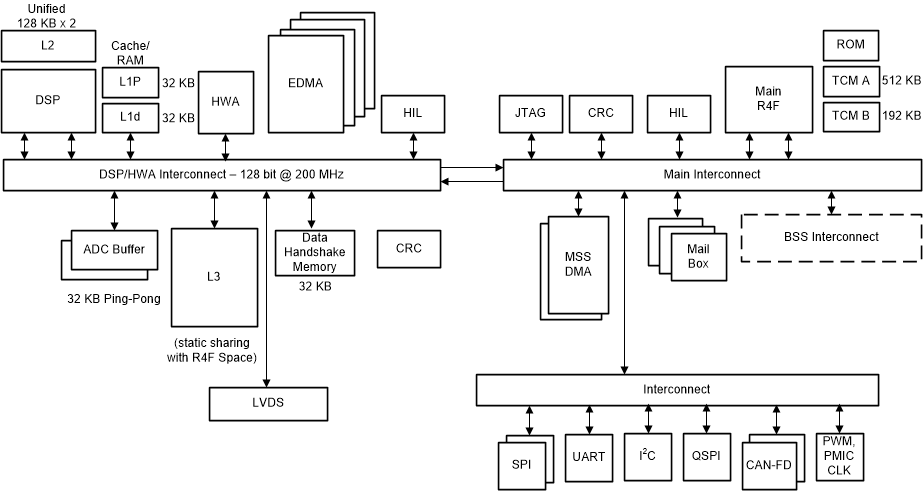ZHCSL77E April 2020 – April 2025 AWR6443 , AWR6843
PRODUCTION DATA
- 1
- 1 特性
- 2 应用
- 3 说明
- 4 功能方框图
- 5 器件比较
- 6 端子配置和功能
-
7 规格
- 7.1 绝对最大额定值
- 7.2 ESD 等级
- 7.3 上电小时数 (POH)
- 7.4 建议运行条件
- 7.5 一次性可编程 (OTP) 电子保险丝的 VPP 规格
- 7.6 电源规格
- 7.7 功耗摘要
- 7.8 节能模式
- 7.9 射频规格
- 7.10 CPU 规格
- 7.11 FCBGA 封装的热阻特性 [ABL0161]
- 7.12
时序和开关特性
- 7.12.1 电源时序和复位时序
- 7.12.2 输入时钟和振荡器
- 7.12.3 多缓冲/标准串行外设接口 (MibSPI)
- 7.12.4 LVDS 接口配置
- 7.12.5 通用输入/输出
- 7.12.6 控制器局域网 - 灵活数据速率 (CAN-FD)
- 7.12.7 串行通信接口 (SCI)
- 7.12.8 内部集成电路接口 (I2C)
- 7.12.9 四线串行外设接口 (QSPI)
- 7.12.10 ETM 跟踪接口
- 7.12.11 数据修正模块 (DMM)
- 7.12.12 JTAG 接口
- 8 详细说明
- 9 监控和诊断
- 10应用、实施和布局
- 11器件和文档支持
- 修订历史记录
- 12机械、封装和可订购信息
8.3.2 处理器子系统
 图 8-5 处理器子系统
图 8-5 处理器子系统图 8-5 显示了 AWR6843 器件中客户可编程处理器子系统的方框图。概括来说,有两个客户可编程子系统,图中用虚线隔开。左侧显示的 DSP 子系统包括 TI 的高性能 C674x DSP、硬件加速器、用于实现高性能(128 位,200MHz)的高带宽互连和相关外设(四个用于数据传输的 DMA),
LVDS 接口用于测量数据输出、L3 雷达数据立方体存储器、ADC 缓冲器、CRC 引擎和数据握手存储器(互连上提供的额外存储器)。
AWR6443 器件不支持 DSP 子系统的 C674x DSP 和 L1/L2 RAM 部分,因此可用存储器为 1.4MB,而 IWR6843 器件为 1.75MB。更多有关每款器件支持和不支持的特性的信息,请参阅器件特性比较表。
图的右侧显示了主要子系统。顾名思义,主要子系统是器件的核心,控制着所有器件外设和器件的通用活动。主要子系统包含 Cortex-R4F(主要 R4F)处理器和关联的外设和通用元件,例如 DMA、CRC 和通过外设中心资源(PCR 互连)连接到主要互连的外设(I2C、UART、SPI、CAN-FD、PMIC 时钟模块、PWM 等)。
有关 DSP CPU 内核的详细信息,请访问 http://www.ti.com/product/TMS320C6748。
HIL 模块显示在两个子系统中,可用于执行雷达操作以将采集的数据从外部馈送到器件中,而不需要射频子系统。主要 SS 上的 HIL 用于控制配置,而 DSPSS 上的 HIL 用于将高速 ADC 数据输入到器件。两个 HIL 模块在器件上使用相同的 IO,一个额外的 IO (DMM_MUX_IN) 允许选择其中的任何一个。